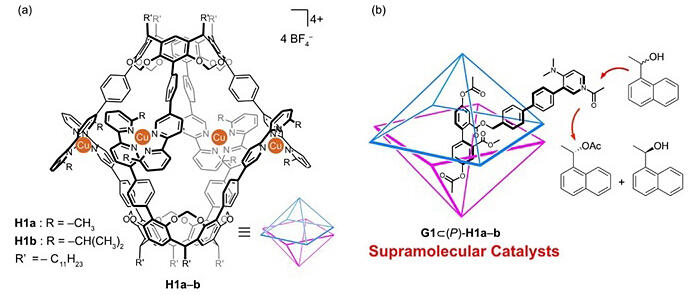Graduate Student Kentaro Harada (JSPS Research Fellowships for Young Scientists), Associate Professor Ryo Sekiya, and Professor Takeharu Haino from the Graduate School of Advanced Science and Engineering at Hiroshima University announced the realization of the enantioselective acylation of secondary alcohols at the exterior of a chiral capsule. This new concept using chiral supramolecular capsules is expected to broaden their applications. The results were published on January 19, 2024 in the international journal Chemistry - A European Journal.

Harada, K.; Sekiya, R.; Haino, T. Kinetic Resolution of Secondary Alcohols Catalyzed at the Exterior of Chiral Coordinated Capsules. Chem. Eur. J. 2024, e202304244.
Supramolecular capsules are capsule molecules with nanometer-sized spaces that have found applications in a variety of fields because these spaces provide a unique reaction environment, which is different from that in solution. It has been demonstrated that the use of nano spaces as a reaction field can lead to different reactions compared to those in solvents. However, such reactions usually require the substrate to be encapsulated in the nano space, which imposes limitations on size and other factors.
To address these limitations, the research group focused on the surface of the chiral supramolecular capsule formed by the self-assembly of resorcinarene with metal ions, exploring the possibility of using this surface as a chiral source. If the space near the surface can be used, the substrate does not need to be encapsulated, eliminating this constraint. The guest molecule was designed by introducing a catalytic moiety into a linear molecule. This guest molecule was then encapsulated in a chiral supramolecular capsule to form a host−guest complex.
The analysis confirmed that the substrate used underwent an enantioselective acylation reaction. The reaction was demonstrated to occur near the surface of the chiral supramolecular capsule, providing a new concept for the use of these capsules. The high versatility of using a variety of catalytic moieties considerably reduces substrate limitations and is expected to pave the way for various supramolecular capsule-based catalyst groups.
Haino remarked, "We had already succeeded in synthesizing optically active supramolecular capsules, but their practical application remained limited. In this study, we developed an asymmetric supramolecular catalyst by encapsulating a guest molecule with a catalytic moiety in an optically active capsule. Emphasis has been placed on the application of the internal vacancies of the supramolecular capsule, but the use of the outer periphery as a reaction field in this report is groundbreaking."
Journal Information
Publication: Chemistry-A European Journal
Title: Kinetic Resolution of Secondary Alcohols Catalyzed at the Exterior of Chiral Coordinated Capsules
DOI: 10.1002/chem.202304244
This article has been translated by JST with permission from The Science News Ltd. (https://sci-news.co.jp/). Unauthorized reproduction of the article and photographs is prohibited.




